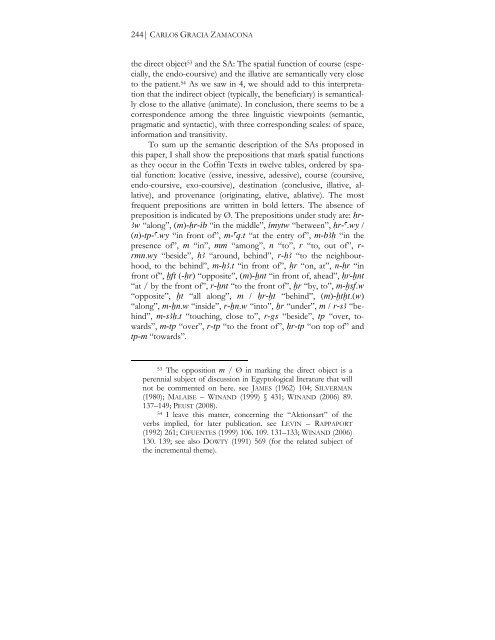“semitisches pantheon”. eine “männliche tyche” - MOSAIKjournal.com
“semitisches pantheon”. eine “männliche tyche” - MOSAIKjournal.com
“semitisches pantheon”. eine “männliche tyche” - MOSAIKjournal.com
Sie wollen auch ein ePaper? Erhöhen Sie die Reichweite Ihrer Titel.
YUMPU macht aus Druck-PDFs automatisch weboptimierte ePaper, die Google liebt.
244| CARLOS GRACIA ZAMACONA<br />
the direct object 53 and the SA: The spatial function of course (especially,<br />
the endo-coursive) and the illative are semantically very close<br />
to the patient. 54 As we saw in 4, we should add to this interpretation<br />
that the indirect object (typically, the beneficiary) is semantically<br />
close to the allative (animate). In conclusion, there seems to be a<br />
correspondence among the three linguistic viewpoints (semantic,<br />
pragmatic and syntactic), with three corresponding scales: of space,<br />
information and transitivity.<br />
To sum up the semantic description of the SAs proposed in<br />
this paper, I shall show the prepositions that mark spatial functions<br />
as they occur in the Coffin Texts in twelve tables, ordered by spatial<br />
function: locative (essive, inessive, adessive), course (coursive,<br />
endo-coursive, exo-coursive), destination (conclusive, illative, allative),<br />
and provenance (originating, elative, ablative). The most<br />
frequent prepositions are written in bold letters. The absence of<br />
preposition is indicated by Ø. The prepositions under study are: Hr-<br />
Aw “along”, (m)-Hr-ib “in the middle”, imytw “between”, Hr-a.wy /<br />
(n)-tp-a.wy “in front of”, m-ao.t “at the entry of”, m-bAH “in the<br />
presence of”, m “in”, mm “among”, n “to”, r “to, out of”, rrmn.wy<br />
“beside”, HA “around, behind”, r-HA “to the neighbourhood,<br />
to the behind”, m-HA.t “in front of”, Hr “on, at”, n-Hr “in<br />
front of”, xft (-Hr) “opposite”, (m)-xnt “in front of, ahead”, Hr-xnt<br />
“at / by the front of”, r-xnt “to the front of”, xr “by, to”, m-xsf.w<br />
“opposite”, xt “all along”, m / Hr-xt “behind”, (m)-xtxt.(w)<br />
“along”, m-Xn.w “inside”, r-Xn.w “into”, Xr “under”, m / r-sA “behind”,<br />
m-sAH.t “touching, close to”, r-gs “beside”, tp “over, towards”,<br />
m-tp “over”, r-tp “to the front of”, Hr-tp “on top of” and<br />
tp-m “towards”.<br />
53 The opposition m / Ø in marking the direct object is a<br />
perennial subject of discussion in Egyptological literature that will<br />
not be <strong>com</strong>mented on here. see JAMES (1962) 104; SILVERMAN<br />
(1980); MALAISE – WINAND (1999) § 431; WINAND (2006) 89.<br />
137–149; PEUST (2008).<br />
54 I leave this matter, concerning the “Aktionsart” of the<br />
verbs implied, for later publication. see LEVIN – RAPPAPORT<br />
(1992) 261; CIFUENTES (1999) 106. 109. 131–133; WINAND (2006)<br />
130. 139; see also DOWTY (1991) 569 (for the related subject of<br />
the incremental theme).




